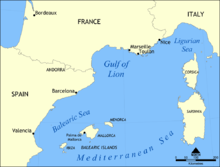Gulf of Lion

The Gulf of Lion (French: golfe du Lion, Spanish: golfo de León, Italian: Golfo del Leone, Occitan: golf del/dau Leon, Catalan: golf del Lleó, Medieval Latin: sinus Leonis, mare Leonis, Classical Latin: sinus Gallicus) is a wide embayment of the Mediterranean coastline of Languedoc-Roussillon and Provence in France, reaching from the border with Catalonia in the west to Toulon.
The chief port on the gulf is Marseille. Toulon is another important port. The fishing industry in the gulf is based on hake (Merluccius merluccius), being bottom-trawled, long-lined and gill-netted and currently declining from over-fishing.
Rivers that empty into the gulf include the Tech, Têt, Aude, Orb, Hérault, Vidourle, and the Rhône.
The continental shelf is exposed here as a wide coastal plain, and the offshore terrain slopes rapidly to the Mediterranean's abyssal plain. Much of the coastline is composed of lagoons and salt marsh.
This is the area of the cold, blustery winds called the Mistral and the Tramontane.
Etymology
The current name of the Gulf appeared at least during the 13th century (in medieval Latin sinus Leonis, mare Leonis) and could come from comparison with a lion: it would simply suggest that this part of the sea is as dangerous as a lion because it has very violent, surprising winds that threaten boats (sailors and fishermen know these dangers very well[1]). This comparison with a lion is suggested by various converging sources: Deroy and Mulon's dictionary of French place names,[2] Mistral's comprehensive Occitan dictionary,[3] Diderot and D'Alembert's famous French encyclopedia[4] and several texts in Latin since the 13th century.[5][6]
These sources, especially Deroy and Mulon, Diderot and D'Alembert, reject the hypothesis according to which the name would be related to the city of Lyon, since it is too far from the gulf.
A former name in classical Latin during Roman antiquity was sinus Gallicus (that is, "Gaulish gulf").
Geodynamics
The Gulf of Lion is not a simple passive continental margin; it results from Oligocene-Miocene anti-clockwise rotation of the Corsican-Sardinian Block against the European Craton. This extension rejuvenated a very complex tectonic framework inherited from the Tethyan evolution and the Pyrenean orogeny. The Eocene mountain-building event that built the Pyrenees compressed and thickened the entire crust. Oil geologists predict that there will be considerable oil deposits at the seaward margins of the gulf.
Marine ecology
The Gulf of Lion is notable, according to C. Michael Hogan, for occurrences of biodiversity associated with the reef building organism Lophelia pertusa.[7]
References
- ↑ Louis Michel, 1964, La langue des pêcheurs du golfe du Lion, Paris: D'Artrey
- ↑ Louis Deroy, & Marianne Mulon, 1994, Dictionnaire des noms de lieux, Paris: Le Robert
- ↑ Frederic Mistral, 1878-1886 (1979), Lou Tresor dóu Felibrige ou dictionnaire provençal-français, Aix-en-Provence: Edisud, see. articles gou (golf, 'gulf') and lioun (leon, 'lion').
- ↑ (French)Encyclopédie ou dictionnaire raisonné des sciences, des arts et des métiers
- ↑ (French)Supplément à l'Encyclopédie, Sinus Gallicus
- ↑ (French)Mémoires pour l'histoire naturelle de la province de Languedoc
- ↑ C. Michael Hogan. 2011. Alboran Sea. eds. P. Saundry & C. J. Cleveland. Encyclopedia of Earth. National Council for Science and the Environment. Washington DC
External links
Coordinates: 42°59′47″N 4°00′01″E / 42.99639°N 4.00028°E